CORDOBA TOURIST INFORMATION
CORDOBA
Córdoba, a transitional province between the Andes and the Pampas, is a very popular destination for Argentine tourists even if almost overlooked by foreigners. Excluding Patagonia, it lies in the virtual centre of the country, bound by the Andean provinces to the north-west, Cuyo to the south- west, the Chaco to the north-east, and the Pampas to the south-east. Most of the province is agricultural, but its major attractions are the city of Córdoba and its scenic mountain hinterland, the Sierras de Córdoba.
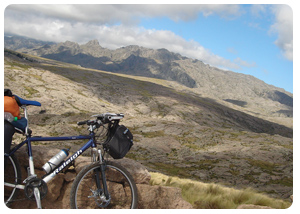 |
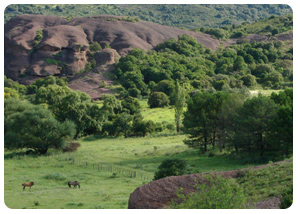 |
The city of Córdoba, capital of the province, holds a special place in colonial and modern Argentine history. It is Argentina’s second city and long a rival with Buenos Aires for political, economic and cultural supremacy. From the early 17th century, its churches and universities were among the best in Latin América, while Buenos Aires languished at the end of Spain´s circuitous mercantile supply route. Today, it is one of Argentina’s most important industrial centre, especially important as the heart of the Argentine automotive industry.
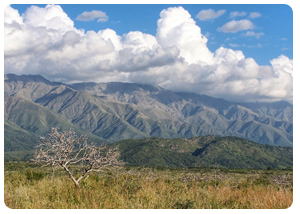 |
 |
The geologically complex Sierras, consisting of three longitudinal ranges reaching as high as 2800 meters, stretch 500 Km from north to south, separating the Pampas from the Andes. Giving birth to several east flowing rivers, prosaically named Primero (First), Segundo (Second), Tercero (Third) and Cuarto (Fourth), they brings visitors the year round to dozens of small towns and villages dedicated to the tourist trade. In the north-east of the province, the Río Primero drains into the Laguna Mar Chiquita, a shallow inland sea.
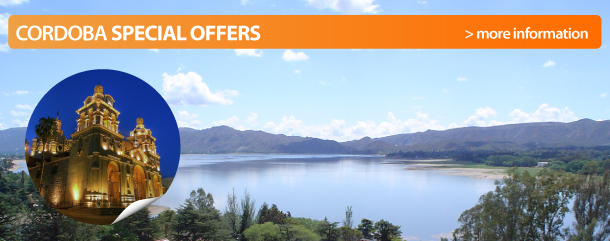
Many of the province’s features appeal to conventional tastes, but there are also opportunities off the beaten track. Historical resources are especially abundant, varied and appealing.
The province of Córdoba and its Capital city of the same name have had an important role in Argentine history. Before Buenos Aires became the country’s major hub, Córdoba served as an essential linking point between the Spanish in Peru and Spain. Gradually, Buenos Aires became the center of things and left the province to its rolling hills and quiet lakes.
Córdoba mark the center of the region; from here the hills spill out, dotted with charming mountain towns. Some are tiny and others are big resorts with everything you would expect. A meandering drive through these mountains towns is a lovely way to spend a day or two or even an entire summer.
Food in Córdoba’s mountain towns is traditional and meat based. Not only Córdoba is famous for its beef, but it’s also known for its barbecued kid. Another specialty is alfajores (dulce de leche sandwiched between two cookies). Although each town may not have a full-scale restaurant, there’s usually an inn or a coffe shop.
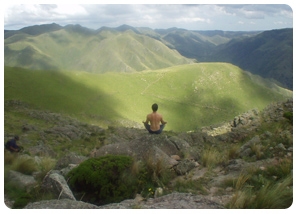 |
 |
CÓRDOBA CITY
It is located 710 kms (426mi) northwest of Buenos Aires.
Córdoba is the Capital city of the province of the same name. The southern plains of the Córdoba province from the northern part of Las Pampas. The town itself was founded in 1573, before Buenos Aires was even an idea. Today Córdoba is the second-largest city in Argentina. But it’s still struggling between the modernization that it has so resisted and the traditional lifestyle that has been holding it back from prosperity.
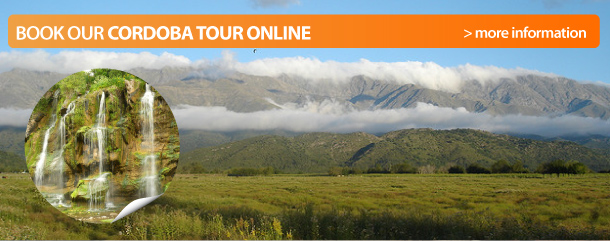
This contrast is apparent: Beautiful parks and historic 17th –century buildings like the cabildo, rest side with industrial buildings (the city is a manufacturing hub, principally for the auto industry). Also notable is the abundance of churches in Córdoba, a testament to the city’s intensely Catholic past. The city is known, too, for its university, giving the city its nickname, La Docta. The parque Sarmiento (Sarmiento Park), designed by French architect Carlos Thays, is a nice place to take a break; it’s especially crowed on weekends. A good day trip out of Córdoba is to nearby mountain towns such as Villa Carlos Paz; most are centered around lake activity or Mountain climbing (and often both).
 |
 |
SIERRAS DE CÓRDOBA
The Sierras de Córdoba offer literally hundreds of small towns and even tinier villages whose attractions range from the reservoirs, beaches and casinos of resorts like Villa Carlos Paz to more sedate places like Cosquín or Candonga. The area is very picturesque, with many sites of historical interest. The Sierra’s dense network of roads, many well paved but some graveled, make it a good candidate for bicycle touring Argentine drivers here seem a bit less ruthless than elsewhere in the country. A mountain bike would suffice if you plan your itinerary well.
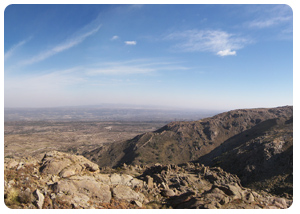 |
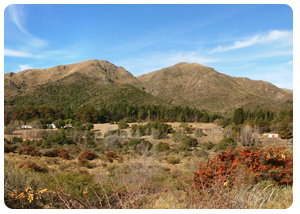 |
VILLA CARLOS PAZ
It is located 36km (22mi) west of Cordoba.
Rapidly expanding, hilltop Villa Carlos Paz is one of the province’s major cities after Córdoba. It’s a popular summer destination for Argentines, who come to swim in the Lago San Roque (San Roque Lake) and go hiking, mountain biking, horseback riding, and fishing. A walk around town gives you a sense of why it’s so charming. The town’s central pedestrian walkway is lined out with shops and cafés, filled both day and night.
 |
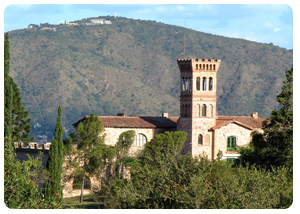 |
Outdoors, activities and sports in Villa Carlos Paz
The activities listed below are available in most of the mountain towns around Córdoba, but equipment and information are far easier to come by in Villa Carlos Paz.
Fishing
Trout fishing seasons is from November to March. The waters around Villa Carlos Paz are generally packed with the fish, which were originally stocked in the lakes years ago to satisfy the needs of British tourists. Most people fish on their own, but the tourist office can put you in touch with fishermen who will pick you up at your hotel, rent your equipment, and bring you out for a day on their boats.
Hiking
Hiking trips, lasting anywhere from one day to a week, are gaining popularity in the area. Hikers typically focus on climbing the Cerro Champaquí, travelling along the Sierras Grandes, or visiting the Volcanes de Pocho.
Mountain biking
The most common mountain-bike adventure in the area is the tour of Los Grandes lagos. Another good spot to go mountain biking is in the nearby village of La Cumbrecita.
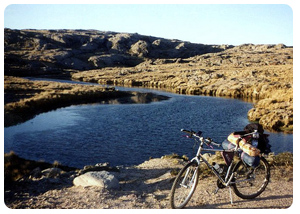 |
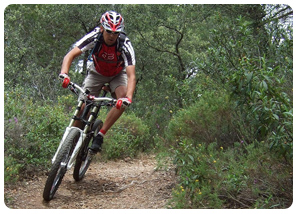 |
LA FALDA
It is located 66km (41mi) northwest of Córdoba.
Like most resorts towns, the primary activities in La Falda are relaxing and strolling the streets, Avenida Diagonal San Martin, Avenida Santa Fe, Avenida Córdoba sud, and Avenida Eden are the town’s central streets. Another good spot for walking is the Plaza Villa Eden, the park between Diagonal Santa Fe, Libertad, and Independencia. But the town’s pride and joy and the reason it was founded in the first place is the famous Hotel Eden. The man responsible for the construction of the Hotel, at the turn of the last century, was German colonel Robert Bahlke, who had become enamored of the region.
The once-luxurious 100-room structure was originally frequented by socialites, old-moneyed elite, and luminaries such as Albert Einstein (in 1925). But its ignominious claim to fame came during World War II, when it was supposedly used as a hideout for Nazi soldiers (townspeople will often tell you that their parents or grandparents saw Hitler here, although there’s no proof he was ever in La Falda). And in 1945 the Argentine government sequestered Japanese diplomats and their families here before deporting them. The hotel closed its doors to guests in 1965, but it’s still La Falda’s most recognizable landmark. Presently, funding is awaited in order to reopen it as a casino or a casino-hotel.
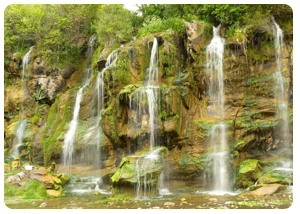 |
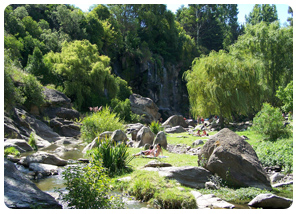 |
The Iglesia del Santisimo Sacramento is another one of La Falda’s landmarks. At 3.082 ft above sea level (the highest point in the city) its neo-Romantic architecture is visible from most points in town. If you’re geology buff, head to the Museo del Viejo Minero (Mineral Musuem), which has one of the country’s most representative collections of natural minerals.
LA CUMBRE
It is located 50kms (31mi) north of Villa Carlos Paz.
Originally constructed by British railway workers in the late 1800s, La Cumbre has a distinctively Victorian look. That, combined with its elevation of 1.400ft and its now predominantly Swiss population, makes the town seem as if it’s in the Alps.
 |
 |
VILLA GENERAL BELGRANO
It is located 88 (54mi) south of Córdoba, 12km (7mi) north of Santa Rosa de la Calamuchita.
Between two picturesque little lakes, Embalse del Rio Tercero and embalse de los Molino, Villa General Belgrano is a perfect place to relax and enjoy a slightly less Latin Version of Argentina. Reminiscent of southern Germany, it stands to reason that it was Bavarians and Alsatians who originally settled this Calamuchita Valley town. Today it strives to retain its German heritage, with an Oktoberfest, the Festival Nacional de la Cerveza, the Viennese Cookie Festival, and an Alpine Chocolate Festival.
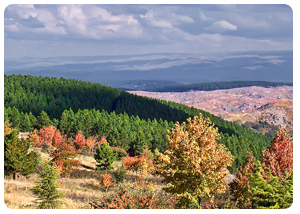 |
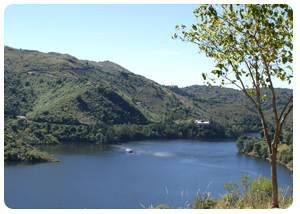 |
SANTA ROSA DE CALAMUCHITA
It is located 12 km (7mi) south of Villa General Belgrano.
In the Calamuchita Valley, Santa Rosa de Calamuchita is one of the most picturesque areas in Córdoba Province and home to Los Grandes Lagos ( The Great Lakes: Embalse del Río Tercero and Embalse de Los Molinos) The main activity in Santa Rosa is strolling along the Rio Santa Rosa and going to its lakeside beaches, including La Choza, La Olla, and Puchuquí, all equipped with chairs and unbrellas.
|



